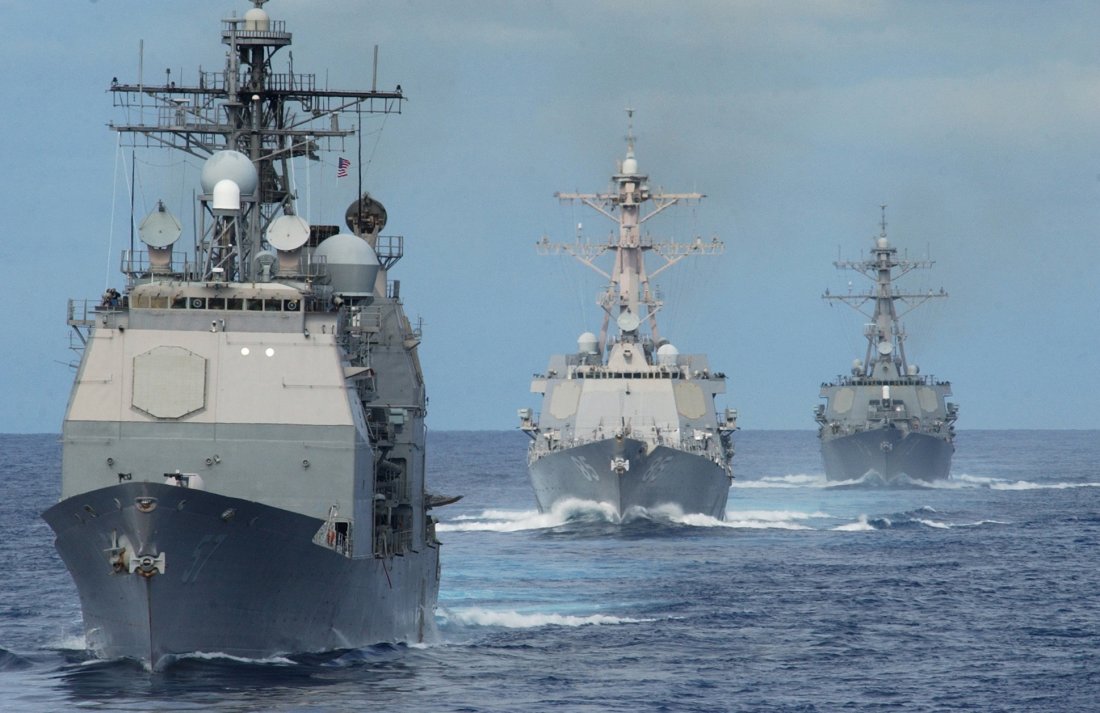by James Holmes
 What would happen should a U.S. Navy warship collide with a Chinese vessel while demonstrating on behalf of freedom of the sea?
What would happen should a U.S. Navy warship collide with a Chinese vessel while demonstrating on behalf of freedom of the sea?
This hasn’t been a trivial or hypothetical question since at least April 2001, when a Chinese fighter jet hotdogging near a U.S. Navy EP-3 surveillance plane slammed into the American aircraft, kindling a diplomatic crisis between the Chinese Communist Party leadership and the newly installed administration of President George W. Bush. This aerial encounter furnished advance warning of what might happen on the surface below.
Last weekend the question took on new urgency. On Sunday morning a People’s Liberation Army Navy (PLAN) Type 052C destroyer cut across the bow of the destroyer USS Decatur as Decatur made a close pass by Gaven Reef in the South China Sea. Estimates vary, but it appears the PLAN ship passed somewhere within 45 feet and 45 yards of its American counterpart—compelling the Decatur bridge crew to maneuver to avoid collision. The imagery is striking. Whatever the actual range, terming this conduct “unsafe and unprofessional”—in the U.S. Pacific Command’s anodyne phrasing—understates how close the vessels came to disaster.
Most such incidents involve the rules of the maritime road: who gets to steam and fly where, and what may seafarers and aviators do along their way? Think of the encounter off Gaven Reef as an exchange of point and counterpoint in an armed conversation about who makes the rules governing the use of sea and sky and who obeys them. And the point of this conversation isn’t merely to impress Chinese and American audiences. It’s to make an impression on foreign audiences able to influence the outcome of the U.S.-China struggle over freedom of the sea.
Audiences such as Vietnam and the Philippines, stakeholders in the maritime disputes roiling the region. Such as Australia and India, friends that incline to stand beside a resolute America but might stand aside should Beijing successfully brand Washington as vacillating and untrustworthy. And such as France and Great Britain, extraregional players whose governments are increasingly vocal about the common and whose navies increasingly share the burden of upholding nautical liberty. Europeans are speaking up—and showing up in embattled waters to back their words with steel.
China calls its opinion-shaping enterprise the “ three warfares ” and prosecutes it through legal, psychological, and media means on a 24/7/365 basis. Three-warfares efforts have a passive-aggressive cast to them: Beijing tries to depict itself as a put-upon Asian power facing a domineering United States and as a masterful defender of Chinese sovereignty and dignity vis-à-vis a hapless U.S. Navy. It flirts with doublethink.
This armed conversation evokes French soldier and counterinsurgency theorist David Galula’s dichotomy between incumbent governments and insurgent groups trying to overthrow them. Galula observes that the challenger is free to say anything to discredit the government and attract popular support, while the incumbent has a reputation to worry about along with a track record for judging whether its deeds match its words. Insurgent leaders harbor few qualms about propagating fake news if it advances the political narrative, while the government tries to get its facts straight before putting out an official version of events.
Insurgents typically get their message out first—and make the all-important first impression. China plays the part of the insurgents Galula describes, whereas the United States is the overseer of the system of maritime freedom. Washington is commonly a latecomer to propaganda battles. It has to set false first impressions straight—and that’s a hard thing to do. Now it’s worth looking at some past near misses and their diplomatic repercussions in order to peer ahead. Some basic questions to ask: what type of craft were involved, under what circumstances did the encounter take place, and who played the propaganda and blame games better? Such factors determine the victor.
The likeliest collision scenario would involve a U.S. Navy warship and a Chinese fishing boat or China Coast Guard cutter. Beijing uses fishing craft crewed by maritime militiamen and backed by cutters as the vanguard of its strategy in the South China Sea and East China Sea. It floods the zone with them to the tune of thousands of fishing craft. Trawlers ply their trade in expanses where China asserts sovereign rights to natural resources. China Coast Guard white hulls dash to the rescue if a rival navy or coast guard challenges the fishing fleet’s presence.
This is the paramilitary fleet that harassed the U.S. survey ship Impeccable in 2009 and has faced off against Philippine and Vietnamese maritime forces. There hasn’t been a collision yet—quite—but there have been close calls. Should non-military ships block the path of an American warship and a crash ensue, the optics—photos of a hulking destroyer mowing down a civilian vessel—would favor Chinese efforts to brand the U.S. Navy as overbearing, blundering, or both. The truth would take a backseat to messaging.
No comments:
Post a Comment